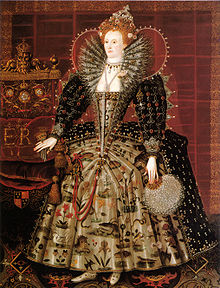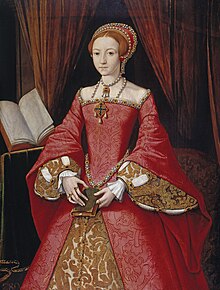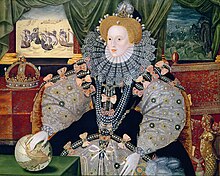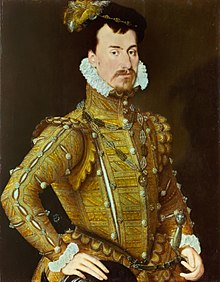Elizabeth I
| Elizabeth I | |
|---|---|
 Portrait c. 1592 | |
| Queen of England and Ireland | |
| Reign | 17 November 1558 – 24 March 1603 |
| Coronation | 15 January 1559 |
| Predecessors | Mary I and Philip |
| Successor | James I |
| Born | Elizabeth Tudor of Greenwich 7 September 1533 Palace of Placentia, Greenwich, England |
| Died | 24 March 1603 (aged 69) Richmond Palace, Surrey, England |
| Burial | |
| Lover | Robert Dudley, 1st Earl of Leicester |
| Issue | Robert Dudley (disputed) |
| House | House of Tudor |
| Father | Henry VIII |
| Mother | Anne Boleyn |
| Religion | Church of England |
| Signature | |
Elizabeth I (7 September 1533 – 24 March 1603) was the Queen of England and Ireland. She was Queen from 17 November 1558 until she died in March 1603. She was also called Good Queen Bess or the Virgin Queen or Gloriana.
She was the daughter of King Henry VIII of England and Anne Boleyn, his second wife, and was the last of the Tudor dynasty of monarchs. When Boleyn was disgraced at court and executed, Elizabeth's life became a troubled one, including being locked up in the Tower of London, an old prison, suspected of helping Queen Mary's enemies.
Despite that, Elizabeth reigned with intelligence and hard work. Her reign was distinguished with great achievements in the arts, trade, and exploration. She ably defended her country through the days of the Spanish Armada. She never married, but claimed that she was married to England. She also had a few other favourites, including the Earl of Leicester. At her death in 1603, King James VI of Scotland was named her successor.
Early life[change | change source]
Elizabeth was born in 1533 at Greenwich, England. She was the daughter of King Henry VIII of England and his second wife, Anne Boleyn. She had an older half-sister Mary, and, later, a younger half-brother Edward.[1]

Elizabeth was given a good education. She could speak and read six languages: her native English, as well as French, Italian, Spanish, Greek, and Latin.[2]
When she was thirteen and a half years old, on 28 January 1547, King Henry died. Elizabeth's half-brother, Edward, became King Edward VI of England. He died age 15. Mary succeeded him in 1553, and after Queen Mary's death in 1558, Elizabeth became Queen.[1]
Achievements as Queen[change | change source]

Mary I had brought back the Roman Catholic religion in England. Elizabeth returned the nation to the Church of England of her father. She did however retain some of the Catholic traditions. She wanted her subjects to make it look like they were being Protestant even if they were not.[2]
The years of Elizabeth's reign had many artistic achievements. William Shakespeare, Christopher Marlowe, Edmund Spenser, and other writers created enduring drama and poetry. Composers Thomas Tallis and William Byrd worked at Elizabeth's court.[2]
During her reign, many men sought adventure abroad. Elizabeth rented a slave ship to John Hawkins and gave him weapons and equipment to keep slave trading.[3][4] Sir Francis Drake, Sir Walter Raleigh, Humphrey Gilbert, and other "sea dogs" looted Spanish ships. They also sailed to the Americas.[5] In 1580, Drake became the first Englishman to sail around the world.[2] The expeditions of these men prepared England to join the age of discovery and international trade and owning other parts of the world. In 1600, Elizabeth herself founded a trading company known as the East India Company that became an important tool of the British Empire.[1]
Spanish Armada[change | change source]


England and Spain had long quarrelled. Elizabeth encouraged Protestants in the Spanish-held Netherlands to rebel against Spain. She also encouraged her "sea dogs" to raid Spanish ships. In 1588, King Philip II of Spain sent an armada (a large fleet of ships) to invade England.
Elizabeth met her troops at Tilbury telling them: "I know I have the body of a weak, feeble woman; but I have the heart and stomach of a king – and of a King of England too".[2]
The Spanish Armada was met by England's smaller ships on 29 July 1588. They defeated the Armada. The Armada was driven by southwest winds to the north. The English fleet harried it up the east coast of England. The Armada returned to Spain round the north of Scotland and south around Ireland. Bad weather near Scotland and Ireland wrecked some of the ships. More than a third of the ships failed to return to Spain.[5]
Queen's noblemen[change | change source]

Elizabeth never married, and she had no children. However, she was fond of several noblemen in her court. Prominent among these noblemen was Robert Dudley, 1st Earl of Leicester. Later, she turned to Robert Devereux, 2nd Earl of Essex. He wanted to overthrow the government of the Queen. He was defeated and executed.[6]
Elizabeth's death[change | change source]
Elizabeth died at Richmond Palace on 24 March 1603. The Protestant King of Scotland James VI became King of England. He was the son of her cousin Mary, Queen of Scots.[2]
Elizabeth I was the last Tudor monarch, and reigned for 44 years. Her accession date was a national holiday for two hundred years.[1]
References[change | change source]
- ↑ 1.0 1.1 1.2 1.3 The Official Website of the British Monarchy: Elizabeth I (r.1558-1603), The Royal Household, retrieved 2014-08-29
- ↑ 2.0 2.1 2.2 2.3 2.4 2.5 BBC History: Elizabeth I, BBC, retrieved 2014-08-29
- ↑ Scott, Shalman (2018-03-25). "The British monarchy's involvement in slavery". Jamaica Observer. Archived from the original on 2020-11-12. Retrieved 2020-11-17.
- ↑ "John Hawkins | Admiral, Privateer, Slave Trader". Royal Museums Greenwich. 2018-07-17. Retrieved 2020-11-17.
Early in his career, he led an expedition in which he violently captured 300 Africans in Sierra Leone and transported them to Spanish plantations in the Americas. There he traded them for pearls, hides, and sugar. His missions were so lucrative that Queen Elizabeth I sponsored his subsequent journeys and provided ships, supplies and guns. She also gave him a unique coat of arms bearing a bound slave.
- ↑ 5.0 5.1 Gibbs, Gary C. (2012), Elizabeth I, vol. 6, The World Book Encyclopedia
- ↑ BBC History: Robert, Earl of Essex (1566 - 1601), BBC, retrieved 2014-08-29
Related pages[change | change source]
Other websites[change | change source]
- Elizabeth I -Citizendium
